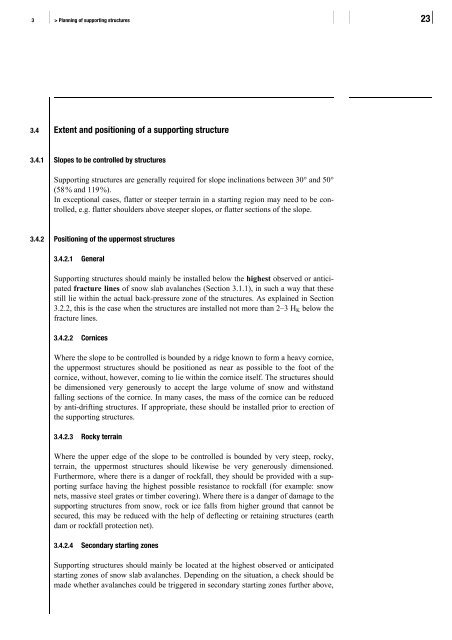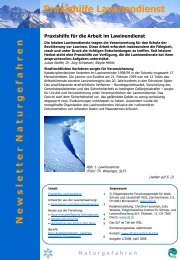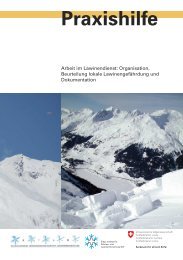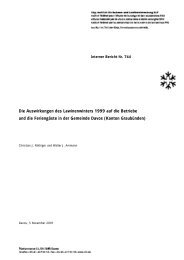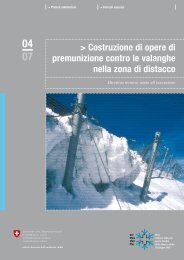Defense structures in avalanche starting zones - SLF
Defense structures in avalanche starting zones - SLF
Defense structures in avalanche starting zones - SLF
You also want an ePaper? Increase the reach of your titles
YUMPU automatically turns print PDFs into web optimized ePapers that Google loves.
3 > Plann<strong>in</strong>g of support<strong>in</strong>g <strong>structures</strong> 23<br />
3.4 Extent and position<strong>in</strong>g of a support<strong>in</strong>g structure<br />
3.4.1 Slopes to be controlled by <strong>structures</strong><br />
Support<strong>in</strong>g <strong>structures</strong> are generally required for slope <strong>in</strong>cl<strong>in</strong>ations between 30° and 50°<br />
(58 % and 119 %).<br />
In exceptional cases, flatter or steeper terra<strong>in</strong> <strong>in</strong> a start<strong>in</strong>g region may need to be controlled,<br />
e.g. flatter shoulders above steeper slopes, or flatter sections of the slope.<br />
3.4.2 Position<strong>in</strong>g of the uppermost <strong>structures</strong><br />
3.4.2.1 General<br />
Support<strong>in</strong>g <strong>structures</strong> should ma<strong>in</strong>ly be <strong>in</strong>stalled below the highest observed or anticipated<br />
fracture l<strong>in</strong>es of snow slab <strong>avalanche</strong>s (Section 3.1.1), <strong>in</strong> such a way that these<br />
still lie with<strong>in</strong> the actual back-pressure zone of the <strong>structures</strong>. As expla<strong>in</strong>ed <strong>in</strong> Section<br />
3.2.2, this is the case when the <strong>structures</strong> are <strong>in</strong>stalled not more than 2–3 HK below the<br />
fracture l<strong>in</strong>es.<br />
3.4.2.2 Cornices<br />
Where the slope to be controlled is bounded by a ridge known to form a heavy cornice,<br />
the uppermost <strong>structures</strong> should be positioned as near as possible to the foot of the<br />
cornice, without, however, com<strong>in</strong>g to lie with<strong>in</strong> the cornice itself. The <strong>structures</strong> should<br />
be dimensioned very generously to accept the large volume of snow and withstand<br />
fall<strong>in</strong>g sections of the cornice. In many cases, the mass of the cornice can be reduced<br />
by anti-drift<strong>in</strong>g <strong>structures</strong>. If appropriate, these should be <strong>in</strong>stalled prior to erection of<br />
the support<strong>in</strong>g <strong>structures</strong>.<br />
3.4.2.3 Rocky terra<strong>in</strong><br />
Where the upper edge of the slope to be controlled is bounded by very steep, rocky,<br />
terra<strong>in</strong>, the uppermost <strong>structures</strong> should likewise be very generously dimensioned.<br />
Furthermore, where there is a danger of rockfall, they should be provided with a support<strong>in</strong>g<br />
surface hav<strong>in</strong>g the highest possible resistance to rockfall (for example: snow<br />
nets, massive steel grates or timber cover<strong>in</strong>g). Where there is a danger of damage to the<br />
support<strong>in</strong>g <strong>structures</strong> from snow, rock or ice falls from higher ground that cannot be<br />
secured, this may be reduced with the help of deflect<strong>in</strong>g or reta<strong>in</strong><strong>in</strong>g <strong>structures</strong> (earth<br />
dam or rockfall protection net).<br />
3.4.2.4 Secondary start<strong>in</strong>g <strong>zones</strong><br />
Support<strong>in</strong>g <strong>structures</strong> should ma<strong>in</strong>ly be located at the highest observed or anticipated<br />
start<strong>in</strong>g <strong>zones</strong> of snow slab <strong>avalanche</strong>s. Depend<strong>in</strong>g on the situation, a check should be<br />
made whether <strong>avalanche</strong>s could be triggered <strong>in</strong> secondary start<strong>in</strong>g <strong>zones</strong> further above,


